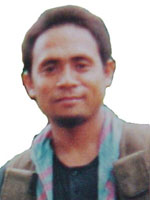Isnilon Hapilon facts for kids
Quick facts for kids
Isnilon Hapilon
|
|
|---|---|

Image of Isnilon Hapilon used in a US government poster from 2006
|
|
| Birth name | Isnilon Totoni Hapilon |
| Born | March 10, 1968 Maluso, Basilan, Philippines |
| Died | October 16, 2017 (aged 49) Marawi, Lanao del Sur, Philippines |
| Allegiance | (1985–1994) (1994–2017) (1994–2014) (2014–2017) |
| Battles/wars | Moro conflict Battle of Tipo-Tipo Marawi crisis † |
Isnilon Totoni Hapilon (born March 10, 1968 – died October 16, 2017) was a Filipino militant leader. He was also known by his other name, Abu Abdullah al-Filipini. He was linked to the ISIS group.
Hapilon used to lead the Abu Sayyaf Group. Later, his group promised loyalty to Abu Bakr al-Baghdadi, the leader of ISIS. In April 2016, an ISIS newsletter said that Hapilon was chosen as the "emir" (leader) of all ISIS forces in the Philippines.
On October 16, 2017, the Philippine Army killed him during the Battle of Marawi. Another leader, Omar Maute, was also killed.
Contents
Early life and background
Isnilon Totoni Hapilon was born on March 10, 1968, in Maluso, Basilan, Philippines. His mother was Haridja Hapilon, a housekeeper. He had five brothers and sisters. His father was a village imam, a Muslim religious leader.
Hapilon started elementary school in 1978. He finished sixth grade in 1984. He then went to Basilan National High School for one year.
Some reports said that Hapilon earned an engineering degree from the University of the Philippines. However, the university stated in May 2017 that they had no record of him ever being a student there.
The US government described Hapilon as "likable by peers" and "proud and confident." He was about 5 feet 5 inches to 5 feet 7 inches tall. He weighed around 120 pounds.
He used several other names, including Abu Musab, Sol, Abu Tuan, Esnilon, and Salahuddin. He could speak Tausug, Tagalog, Yakan, and Arabic, as well as English. He might have traveled to Saudi Arabia and Malaysia.
Militant activities
Joining the MNLF
Hapilon joined the Moro National Liberation Front (MNLF) in 1985. This was a rebel group in the Philippines. While with the MNLF, he studied Arabic and religious education. He became a spokesperson for one of their commanders in 1992.
With Abu Sayyaf
In 1994, Hapilon joined the Abu Sayyaf group. This group was led by Abdurajak Abubakar Janjalani, who also became his religious teacher. Hapilon quickly became one of the main leaders of Abu Sayyaf.
In 2002, the United States government accused Hapilon and other Abu Sayyaf leaders of being involved in kidnappings. These included the 2000 kidnappings of Filipinos and Americans.
On February 24, 2006, Hapilon was added to the FBI's Most Wanted Terrorists list. The Rewards For Justice Program offered up to US$5 million for information that could lead to his capture.
In July 2002, Philippine authorities tried to arrest Hapilon in Zamboanga City, but he escaped. In May 2008, he was shot in the hand during a military operation. His son, Tabari, who was also a fighter, was killed. Hapilon was also wounded in April 2013 during another military operation.
Leader for ISIS in the Philippines
On July 23, 2014, a video was shared online showing Hapilon and other masked men. In the video, they promised their loyalty to Abu Bakr al-Baghdadi, the leader of ISIS.
On April 9, 2016, Hapilon led about 150 Abu Sayyaf fighters in an attack against government forces in Tipo-Tipo, Basilan. His son, Ubaida, was killed in this fight.
In June 2016, ISIS released a video that named Hapilon as the leader for ISIS in the Philippines. They also called him the "emir" for Southeast Asia. The video encouraged other militants in Southeast Asia to travel to the Philippines and join the fight.
By January 2017, ISIS officially recognized him as their member. He worked to unite different militant groups in the Philippines under ISIS.
In May 2017, the Philippine military and police tried to capture Hapilon in Marawi. This led to a major conflict in the city, known as the Marawi crisis. Hapilon was in Marawi with his supporters during this time.
On October 16, 2017, Isnilon Hapilon and Omar Maute were killed during a military operation in Marawi. The military also rescued 17 hostages. The FBI later confirmed that the DNA from a body found by the military matched Hapilon's.
See also
 In Spanish: Isnilon Totoni Hapilon para niños
In Spanish: Isnilon Totoni Hapilon para niños

